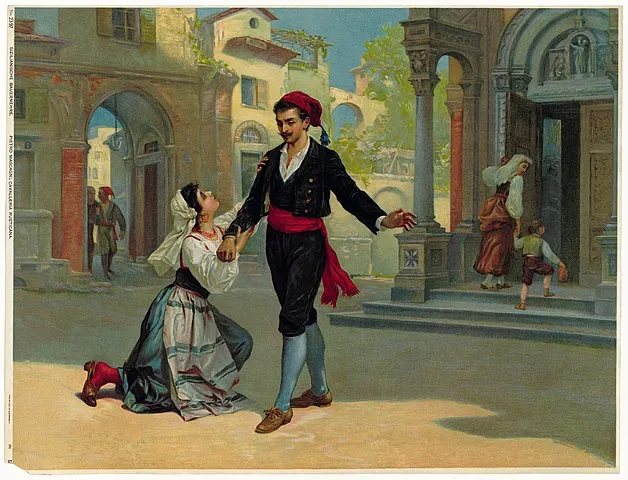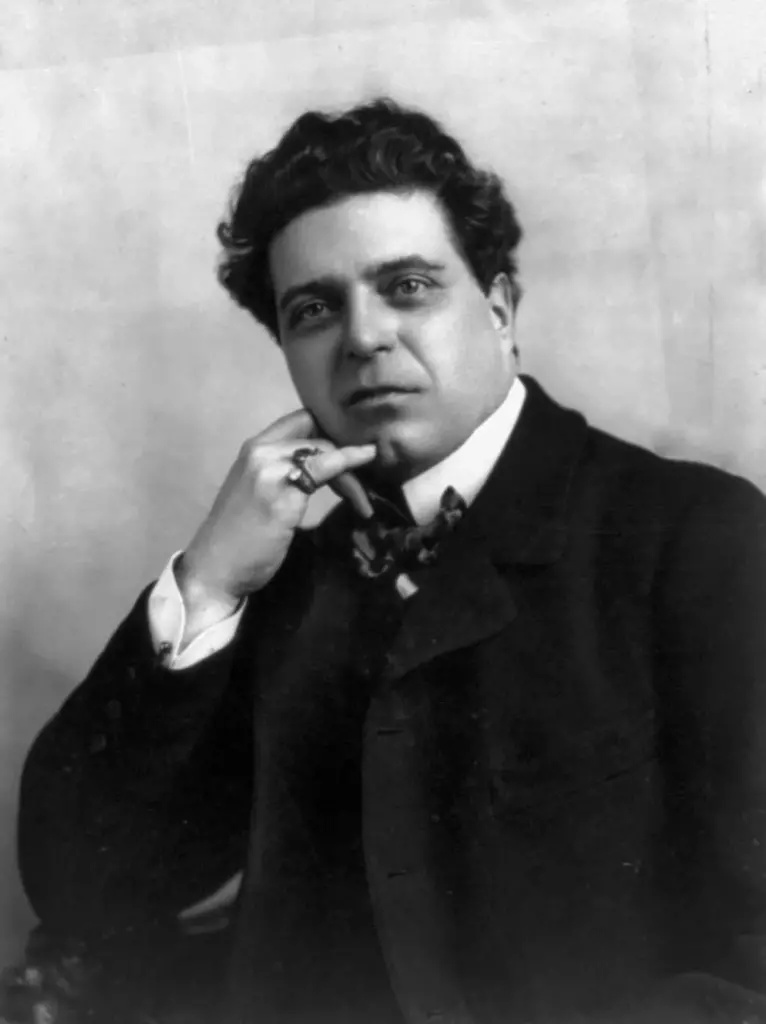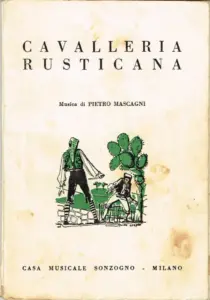
By Cedric Rischitelli
In the history of the Opera tradition, many genres developed over the centuries. The post-Romantic Verismo (Italian for realism) tradition stood apart for its naturalism and for focusing on the lives of the average contemporary people, subjects considered until then too poor and unfit to be protagonists of such pieces.
In the Verismo movement, the most well-known opera is the Cavalleria Rusticana (1890) by Pietro Mascagni, a theatrical masterpiece with a fascinating history and complicated legacy.
Pietro Mascagni and the composition of Cavalleria Rusticana

Pietro Mascagni (1863–1945) was an Italian composer from Tuscany who dedicated his entire life to his musical career. He composed many operas, like L’Amico Fritz (1891), Iris (1898), and Le Maschere (1901). However, Mascagni is mostly known as “one opera man,” as his fame mainly lies in Cavalleria Rusticana‘s incredible success.
Cavalleria Rusticana was adapted after the Italian libretto by Giovanni Targioni-Tozzetti (1863-1934) and Guido Menasci (1867-1925). The story was based on an 1880 short novel by Giovanni Verga (1840-1922), a Sicilian Verismo writer considered the leader of the Italian literary movement.
A young Mascagni asked Targioni-Tozzetti and Menasci to write the libretto for a competition for new composers.
All participants were invited to submit a one-act opera, and three selected winners would then stage their opera in Rome. As the deadline approached, Mascagni almost gave up on applying as he felt the Cavalleria Rusticana had been written too swiftly and without enough effort to win.
However, Mascagni’s wife, Argenide Marcellina ‘Lina’ Mascagni (1862-1946), decided to apply for him on the last day of submission, believing in her husband’s talent. As fate would have it, Lina’s actions led to Mascagni winning the competition and receiving his life’s greatest success.
After Cavalleria Rusticana was first performed at Teatro Costanzi in Rome, the spectators (which included the Italian Queen Margherita of Savoy) went crazy, applauding, screaming, and waving handkerchiefs. That evening, the public symbolically crowed Mascagni as the new king of Italian opera.

The Cavalleria Rusticana, in many ways, shaped and influenced the aesthetic of the Verismo tradition in opera. Notably, it inspired Ruggero Leoncavallo’s Pagliacci (1892). To this day, Cavalleria Rusticana and Pagliacci are regularly played as a double bill.
Synopsis: a tragic Easter Sunday
Cavalleria Rusticana, which can be translated into Rustic Cavalry, is known for its simple plot shaped by jealousy and a fight for honor. With simple yet energetic music, Mascagni captured the power and drama within this bloody story in just one act.
The plot takes place in a small Sicilian village in the late 19th Century, a setting Verga often used in his novels. It is Easter Sunday, and the villagers going to church open the opera by celebrating a beautiful spring morning.
Spring should bring love and new life, yet the village is about to experience a story of romantic affairs, betrayal, and tragedy. Offstage, we hear young Turiddu singing, praising Lola’s beauty and his devoted love for her. However, we soon discover that Turiddu had previously courted Lola, but as he left for the army, the girl married the village’s Carter Alfio.
To comfort himself, once back from the military, Turiddu begins a relationship with a peasant girl named Santuzza, who falls deeply in love with him. Yet, Lola, jealous of Santuzza, now wants her former lover back, and both start an affair.
We learn this as Santuzza sings her tragic ballad to Mamma Lucia, Turrido’s mother and village innkeeper. The audience also meets Alfio as he sings about the joys of his simple life, work, and marriage, still unaware of the affair going behind his back.
When Turiddu finally comes onto the scene – after having spent the previous night with Lola – he and Santuzza argue. The situation escalates as Lola comes on stage and openly mocks Santuzza. Left by Turiddu without love or honor, Santuzza wants revenge and tells Alfio what’s happening. She regrets her actions; however, Alfio swears vengeance and challenges Turridu to a dual.
The villagers’ joys following Easter mass and the beginning of spring are soon forgotten as the terror of the dual takes over. Turiddu suddenly realizes his mistakes and asks his mother to look after poor Santuzza if he does not return. He kisses Mamma Lucia goodbye and rushes offstage. Mamma Lucia and Santuzza are left alone on stage, frightened. The opera ends in tragedy, as a woman cries out that Turiddu has been killed, and Santuzza and Mamma Lucia faint.
-Cavalleria Rusticana, Intermezzo Sinfonico. The symphonic interlude of the opera, located between the eighth and ninth scenes, is one of the most popular pieces. Thanks to its orchestral character, based entirely on the use of strings, it has had great success even outside the operatic repertoire. (Audio and text source: Director: Simon Schindler, Fulda Symphonic Orchestra/Wikipedia)
Complicated legacies
The seventy-minute piece met incredible success during and after Mascagni’s life. The work has been recorded countless times, translated into English, French, German, and Hungarian, and adapted into movies at least five times.
The opera’s Intermezzo has received the most success, being used in many movies’ soundtracks: it was featured in Martin Scorsese’s Raging Bull (1980), Philippe de Broca’s Le Bossu (1997), and Michael Hoffman’s A Midsummer Night’s Dream (1999). Most notably, a performance of Cavalleria Rusticana is featured in the climax of Francis Ford Coppola’s The Godfather Part III. However, aside from the Cavalleria Rusticana, Mascagni’s other compositions have been forgotten for mainly two reasons.
Firstly, the popularity of Mascagni’s Cavalleria Rusticana came to haunt him. Mascagni wrote fifteen operas in total, but none of them could match his initial success. In truth, Mascagni’s repertoire vastly varies in styles, stories, music, and themes. Yet all his future works fell short as they were always unfairly compared to Cavalleria Rusticana‘s beloved style. Some suggest that maybe Mascagni had been crowned ‘the king of Italian opera’ too soon into his career, giving the composer no room for artistic freedom.
Secondly, post World War 2, Mascagni’s reputation was ruined due to his association with the Fascist Party. Due to his political association with the regime, his work (except for Cavalleria Rusticana) has been ignored and forgotten.
It is unclear whether Mascagni’s adhesion to the Fascist Party in 1932 was sincere or just a political move to survive in Mussolini’s Italy. Some even theorize that Mascagni’s final opera, Nerone (1935), was written to attack and criticize the Duce himself. We might never know: Mascagni died just as WW2 was ending, and he had no opportunity to comment on the matter.
While we cannot ignore Mascagni’s connection to Mussolini and Fascism, the Italian composer still deserves our attention and ears. Mascagni refused to play it safe and ride on the fame of the Cavalleria Rusticana. Instead, he moved away from the Verismo movement and experimented with romanticism, orientalism, and comedies.
Mascagni’s fifteen operas all varied in music, moods, and themes. His later compositions are still not widely played in famous opera houses, but we have the fortune to listen to all his work online.
Nonetheless, the Cavalleria Rusticana remains the quintessential example of the Verismo movement. The composition introduced characters from the peasant world, ignored subjects by opera composers for years. With simple yet captivating music and plot, Mascagni drags us into the world his opera creates on stage. Cavalleria Rusticana still deserves the same applauses and praises it received the first time it was played at the Teatro Costanzi in 1890.








Cancel anytime


Using our website
You may use the The Middle Land website subject to the Terms and Conditions set out on this page. Visit this page regularly to check the latest Terms and Conditions. Access and use of this site constitutes your acceptance of the Terms and Conditions in-force at the time of use.
Intellectual property
Names, images and logos displayed on this site that identify The Middle Land are the intellectual property of New San Cai Inc. Copying any of this material is not permitted without prior written approval from the owner of the relevant intellectual property rights.
Requests for such approval should be directed to the competition committee.
Please provide details of your intended use of the relevant material and include your contact details including name, address, telephone number, fax number and email.
Linking policy
You do not have to ask permission to link directly to pages hosted on this website. However, we do not permit our pages to be loaded directly into frames on your website. Our pages must load into the user’s entire window.
The Middle Land is not responsible for the contents or reliability of any site to which it is hyperlinked and does not necessarily endorse the views expressed within them. Linking to or from this site should not be taken as endorsement of any kind. We cannot guarantee that these links will work all the time and have no control over the availability of the linked pages.
Submissions
All information, data, text, graphics or any other materials whatsoever uploaded or transmitted by you is your sole responsibility. This means that you are entirely responsible for all content you upload, post, email or otherwise transmit to the The Middle Land website.
Virus protection
We make every effort to check and test material at all stages of production. It is always recommended to run an anti-virus program on all material downloaded from the Internet. We cannot accept any responsibility for any loss, disruption or damage to your data or computer system, which may occur while using material derived from this website.
Disclaimer
The website is provided ‘as is’, without any representation or endorsement made, and without warranty of any kind whether express or implied.
Your use of any information or materials on this website is entirely at your own risk, for which we shall not be liable. It is your responsibility to ensure any products, services or information available through this website meet your specific requirements.
We do not warrant the operation of this site will be uninterrupted or error free, that defects will be corrected, or that this site or the server that makes it available are free of viruses or represent the full functionality, accuracy and reliability of the materials. In no event will we be liable for any loss or damage including, without limitation, loss of profits, indirect or consequential loss or damage, or any loss or damages whatsoever arising from the use, or loss of data, arising out of – or in connection with – the use of this website.
Last Updated: September 11, 2024
New San Cai Inc. (hereinafter “The Middle Land,” “we,” “us,” or “our”) owns and operates www.themiddleland.com, its affiliated websites and applications (our “Sites”), and provides related products, services, newsletters, and other offerings (together with the Sites, our “Services”) to art lovers and visitors around the world.
This Privacy Policy (the “Policy”) is intended to provide you with information on how we collect, use, and share your personal data. We process personal data from visitors of our Sites, users of our Services, readers or bloggers (collectively, “you” or “your”). Personal data is any information about you. This Policy also describes your choices regarding use, access, and correction of your personal information.
If after reading this Policy you have additional questions or would like further information, please email at middleland@protonmail.com.
PERSONAL DATA WE COLLECT AND HOW WE USE IT
We collect and process personal data only for lawful reasons, such as our legitimate business interests, your consent, or to fulfill our legal or contractual obligations.
Information You Provide to Us
Most of the information Join Talents collects is provided by you voluntarily while using our Services. We do not request highly sensitive data, such as health or medical information, racial or ethnic origin, political opinions, religious or philosophical beliefs, trade union membership, etc. and we ask that you refrain from sending us any such information.
Here are the types of personal data that you voluntarily provide to us:
As a registered users or customers, you may ask us to review or retrieve emails sent to your business. We will access these emails to provide these services for you.
We use the personal data you provide to us for the following business purposes:
Information Obtained from Third-Party Sources
We collect and publish biographical and other information about users, which we use to promote the articles and our bloggers who use our sites. If you provide personal information about others, or if others give us your information, we will only use that information for the specific reason for which it was provided.
Information We Collect by Automated Means
Log Files
The site uses your IP address to help diagnose server problems, and to administer our website. We use your IP addresses to analyze trends and gather broad demographic information for aggregate use.
Every time you access our Site, some data is temporarily stored and processed in a log file, such as your IP addresses, the browser types, the operating systems, the recalled page, or the date and time of the recall. This data is only evaluated for statistical purposes, such as to help us diagnose problems with our servers, to administer our sites, or to improve our Services.
Do Not Track
Your browser or device may include “Do Not Track” functionality. Our information collection and disclosure practices, and the choices that we provide to customers, will continue to operate as described in this Privacy Policy, whether or not a “Do Not Track” signal is received.
HOW WE SHARE YOUR INFORMATION
We may share your personal data with third parties only in the ways that are described in this Privacy Policy. We do not sell, rent, or lease your personal data to third parties, and We does not transfer your personal data to third parties for their direct marketing purposes.
We may share your personal data with third parties as follows:
There may be other instances where we share your personal data with third parties based on your consent.
HOW WE STORE AND SECURE YOUR INFORMATION
We retain your information for as long as your account is active or as needed to provide you Services. If you wish to cancel your account, please contact us middleland@protonmail.com. We will retain and use your personal data as necessary to comply with legal obligations, resolve disputes, and enforce our agreements.
All you and our data are stored in the server in the United States, we do not sales or transfer your personal data to the third party. All information you provide is stored on a secure server, and we generally accepted industry standards to protect the personal data we process both during transmission and once received.
YOUR RIGHTS/OPT OUT
You may correct, update, amend, delete/remove, or deactivate your account and personal data by making the change on your Blog on www.themiddleland.com or by emailing middleland@protonmail.com. We will respond to your request within a reasonable timeframe.
You may choose to stop receiving Join Talents newsletters or marketing emails at any time by following the unsubscribe instructions included in those communications, or you can email us at middleland@protonmail.com
LINKS TO OTHER WEBSITES
The Middle Land include links to other websites whose privacy practices may differ from that of ours. If you submit personal data to any of those sites, your information is governed by their privacy statements. We encourage you to carefully read the Privacy Policy of any website you visit.
NOTE TO PARENTS OR GUARDIANS
Our Services are not intended for use by children, and we do not knowingly or intentionally solicit data from or market to children under the age of 18. We reserve the right to delete the child’s information and the child’s registration on the Sites.
PRIVACY POLICY CHANGES
We may update this Privacy Policy to reflect changes to our personal data processing practices. If any material changes are made, we will notify you on the Sites prior to the change becoming effective. You are encouraged to periodically review this Policy.
HOW TO CONTACT US
If you have any questions about our Privacy Policy, please email middleland@protonmail.com
The Michelin brothers created the guide, which included information like maps, car mechanics listings, hotels and petrol stations across France to spur demand.
The guide began to award stars to fine dining restaurants in 1926.
At first, they offered just one star, the concept was expanded in 1931 to include one, two and three stars. One star establishments represent a “very good restaurant in its category”. Two honour “excellent cooking, worth a detour” and three reward “exceptional cuisine, worth a
Thank you for your participation,
please Log in or Sign up to Vote

123Sign in to your account